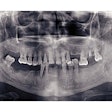
Researchers at the University of Cincinnati studying data from common oral surgeries have found that patients with higher body mass index (BMI) are more difficult to sedate and more prone to respiratory events.
"We are looking at various outcomes in outpatient sedation in patients that need oral surgery, including overweight patients," said study author Deepak G. Krishnan, D.D.S., assistant professor of surgery at the University of Cincinnati Medical Center, in a DrBicuspid.com interview. "Increased BMI seems to be co-relating to increased difficulty in sedating patients and patients needing more airway recovery maneuvers."
And while it might be intuitively considered harder to sedate a patient with increased BMI, "we are proving that hypothesis in a well-controlled prospective study," he added.
The percentage of overweight and obese people in the U.S. is rising, and studying the effects of increased BMI on the surgical management of these patients is a matter of public health concern, the researchers noted.
With 49 states having increased numbers of residents who are classified as overweight and obese based on BMI, there is a good chance that dental practices across the country will see these types of patients, explained Dr. Krishnan.
The findings, which were presented last month at the annual American Association of Oral and Maxillofacial Surgeons meeting in Toronto, are part of a series of ongoing studies being conducted by the university's Division of Oral Maxillofacial Surgery. The researchers are fine tuning a few additional potentially confounding variables, and the final study is likely to be published in the Journal of Oral and Maxillofacial Surgery, according to Dr. Krishnan.
More respiratory events
The prospective study evaluates the relationship between BMI and the level of sedation, level of cooperation, verbal and nonverbal signs of discomfort, and frequency of respiratory events.
Researchers reviewed data from 431 patients -- age 14 to 87 -- who had undergone intravenous sedation at the Division of Oral and Maxillofacial Surgery from December 2008 through April 2009. They noted the patient's age, gender, race, height, weight, procedure performed, level of sedation, level of patient cooperation, verbal and non-verbal signs of discomfort, and frequency of respiratory events.
The level of sedation was assessed using a Modified Ramsey Scale, ranging from 1 (agitated, anxious, restless) to 6 (asleep). The level of patient cooperation and verbal and non-verbal signs of discomfort were scaled and scored. The frequency of respiratory events included the occurrence of pulse oximetry desaturation and the need for airway intervention such as head tilt/chin lift, jaw thrust, pullng out tongue, and airway insertion.
The researchers found that obese patients were more than twice as likely to require airway intervention by physicians, who had to pull their tongue forward, move their jaw, or take other measures to assure the patient’s safe breathing. Those patients with higher BMIs also showed more signs of being less sedated, such as being more agitated, restless, and anxious.
Extra precautions needed
Several pathophysiologic changes combine with multiple comorbidities in the overweight patient to make sedation of these patients challenging, the authors noted.
"This study found statistically significant differences in age, frequency of respiratory events, and display of agitation, anxiousness, and restlessness in individuals with increased BMI versus normal weight individuals," the authors concluded. "The results are indicative of the increased difficulty found in sedating overweight and obese patients."
A 2006 study (Pediatric Dentistry, Nov-Dec 2006, pp.487-493) that looked at the influence of childhood obesity on pharmacosedation in pediatric dentistry noted that obesity increased potential for respiratory complications, hypertension, and gastrointestinal problems.
Sedative drugs dosed on total body weight could oversedate obese patients, while dosages based on lean body mass could undersedate, noted the authors of that study. Extra precautions regarding drug selection (such as avoiding opioids) and proper patient positioning could potentially minimize complications, they advised.
Dr. Krishnan also warned that oral surgeons should take extra precautions when sedating overweight patients.
He offered these tips on the management of such patients:
- A thorough pre-operative evaluation identifying all of the risk factors is key.
- If the risk factors identified that relate to the patient's weight are major, then the surgeon should consider doing the procedure under local anesthesia or general anesthesia in a hospital rather than an office-based setting. This is one reason why it is important for oral and maxillofacial surgeon to maintain hospital privileges and not shy away from the operating room setting, Dr. Krishnan added.
This study was designed to prove that sedation is more cumbersome in overweight patients, while future research will focus on gathering more specific information about optimum drug choice and dosage.
"The information we gather (from these studies) will be the knowledge that empowers every oral surgeon that treats overweight and obese patients in their office to perform safe anesthesia and not cross that thin line that differentiates a safe sedation from a dangerous one," said Dr. Krishnan.



















